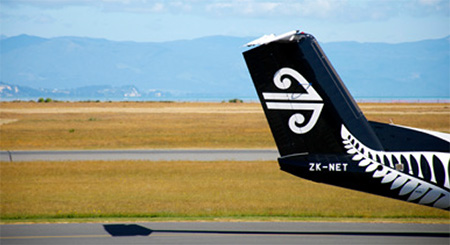By CAA Flight Examiner, Guy Brooking
 Perhaps the very essence of working together to stay apart at uncontrolled aerodromes are VFR and IFR pilots taking each other’s needs into account.
Perhaps the very essence of working together to stay apart at uncontrolled aerodromes are VFR and IFR pilots taking each other’s needs into account.
You’re flying into an uncontrolled aerodrome under IFR, in IMC. It may well be VMC below the cloud in the circuit, but you’re not certain of the cloud base or ceiling. You can hear traffic in the circuit on the radio, but could there also be some non-radio traffic as well? Should you start an approach or do you need to hold?
Or, you’re flying under VFR at the same circuit in the same weather conditions. An IFR flight has begun the approach and made a radio call giving their position. What should you be aware of, and what might you need to consider?
What the rules and guidance say about these situations is what this article is about. It’s aimed at both VFR and IFR pilots.
When an IFR pilot flies an approach to join at an uncontrolled aerodrome, communication and cooperation with the circuit traffic is essential. This really encapsulates the intended meaning of the Work Together, Stay Apart campaign.

Barrier Air flies IFR to the uncontrolled aerodromes of Whitianga, Kaitaia, Great Barrier Island, and from August, Kerikeri. Photo courtesy of Barrier Air.
What the rules and the AIP say
Rule 91.229(f)
A pilot of an aircraft in flight or on the surface must— (1) give way to any aircraft that is in the final stages of an approach to land or is landing.
The term ‘landing’ is clear, while the phrase ‘final stages’ of an approach to land varies according to the type and size of aircraft concerned. It’s referring to the very final stages before landing, where the aircraft is properly configured and slowed down.
For a microlight this might occur within 1NM of the runway, for a light twin it may be at 2NM, whereas for a large turboprop it may occur at 4NM.
Rule 91.223(a)(1)
Except as provided in paragraph (b), a pilot of an aeroplane operating on or in the vicinity of an aerodrome must — (1) observe other aerodrome traffic for the purpose of avoiding a collision.
Essentially, pilots of all flights must maintain a thorough lookout to avoid a collision. This rule is expressed more explicitly in the AIP, below.
AD 1.6 2.1.4
Regardless of whether the flight is performed under IFR or under VFR, pilots must maintain a visual lookout so as to see and avoid other aircraft whilst joining and operating within an unattended aerodrome circuit.
This is an important point for IFR pilots, in particular, to remember – because you may be more focussed on the approach procedure, and the navigation instruments, than on looking outside.
The messaging in the rule and the AIP is the same – everyone is to look out to avoid collisions.
Guidance from the AIP
The AIP guides pilots planning an IFR approach at unattended aerodromes.
ENR 1.5 4.28.3
It is important that the minimum altitude is not infringed and flight to the aerodrome is not continued unless the pilot is satisfied that integration with circuit traffic operating in flight visibilities down to 1500 m can be achieved. Where a traffic confliction is likely, descent in IMC should be restricted to 1200 ft above aerodrome elevation.
IFR pilots should be aware that circuit traffic may be operating in relatively poor weather conditions, and they should carefully consider their ability to integrate with any traffic. Initially this would be achieved with radio communication.
In addition, if an approach is begun in IMC, and there’s doubt about separation with circuit traffic, the approach should be abandoned before descending below 1200 feet above the aerodrome.
The AIP also determines priority when an IFR flight is making an approach at an unattended aerodrome.
AD 1.6 2.1.2
VFR traffic in the circuit should be aware that IFR aircraft conducting instrument approach procedures may join long final. Circuit traffic retains right of way unless weather conditions dictate priority to IFR aircraft on the instrument approach procedure, or if the IFR aircraft is in the final stages of an approach to land.
While this advice refers to ‘right of way’ and ‘priority’, it’s important to remember the goal is more about integrating safely. It’s packed with guidance, which can be divided into three areas.
AWARENESS – PRIORITY – WEATHER
Awareness
 The first part of the statement, “VFR traffic in the circuit should be aware that IFR aircraft conducting instrument approach procedures may join long final”, refers to good situational awareness.
The first part of the statement, “VFR traffic in the circuit should be aware that IFR aircraft conducting instrument approach procedures may join long final”, refers to good situational awareness.
VFR pilots operating in the circuit must prepare and plan properly before departure. Start by finding out if there’s a published instrument approach at the aerodrome. Look for the aerodrome in the AIP, or by looking at the visual navigation chart where there’s a symbol (in the form of an elongated teardrop) for showing instrument approaches at unattended aerodromes. An example of this symbol for Tokoroa can be seen on the right.
Once you know a published instrument approach exists at the aerodrome, you may want to look at the instrument approach published in the AIP.
If you’re not used to looking at IFR charts, be aware that, as a rule of thumb, the final approach track of an instrument approach tends to begin between 10NM and 12NM from the aerodrome. This final portion of the approach is usually aligned to the runway – for instance, for Runway 02, the final portion of the instrument approach will be very close to 020⁰. But note that it can sometimes be slightly offset by a few degrees.
With this knowledge, VFR pilots should be aware that IFR traffic could be joining on a long final, which could be up to 12NM from the runway. Even when not operating in the circuit, VFR pilots should be aware of these instrument approach areas, and avoid flying too close, either laterally or vertically.
If your aircraft is equipped with a transponder, make sure it’s turned on and in ALT mode.
IFR aircraft will be fitted with ADS-B, or even TCAS, and this will help them identify your position.
Priority
The next part of the AIP reference states, “Circuit traffic retains right of way…”.
Considering the case where good visual conditions exist at the aerodrome, any aircraft joining on a long final – including IFR traffic flying the published instrument approach – must give way to traffic in the circuit.
Therefore, if you’re operating under IFR and joining on a long final, you should keep a very good lookout and start listening out early.
As the types of aircraft flying IFR tend to be higher performance, it would be wise to also slow the aircraft down as much as practical. And, be prepared to go around, either into the missed approach, or into the visual circuit to join downwind.
Before arriving at the aerodrome, make a radio call giving your ETA for the initial approach fix, or start of the approach. Follow this with radio calls during the approach to help circuit traffic become aware of your intentions.
In these radio calls, refer to visual features or a bearing and distance from the aerodrome, rather than just the approach waypoints, which VFR circuit traffic may not be familiar with.
VFR pilots can also request a time to touchdown from the IFR pilot, to aid in their awareness. IFR pilots should carry the VNC, and as part of the approach briefing, include a review of the chart and the relevant visual reference points.

Photo: iStock.com/LazingBee
Whether IFR or VFR, pilots joining, or in the circuit of an unattended aerodrome, must display courtesy, airmanship, and cooperation, to ensure they stay safely separated.
IFR pilots joining should remember that circuit traffic has priority. And, of course, consider the possibility of non‑radio traffic in the circuit. Which brings us right back to a thorough lookout and being ready to go around.
VFR circuit pilots should also consider the size of IFR aircraft joining. For larger aircraft, it may be good airmanship to allow them to go first.
This leads us to the next part of the sentence, “…unless weather conditions dictate priority to IFR aircraft on the instrument approach procedure”.
The tricky part here is, what or who determines these weather conditions? VFR traffic could still be in the circuit when the cloud base and/or visibility are relatively low, and in this case, early communication becomes even more important.
VFR circuit pilots must remember that when operating in poor weather conditions, you will need to give priority to IFR joining traffic – something to remember before flying circuits in such conditions. But once again, the possibility of non-radio traffic being in the circuit must be considered by IFR pilots joining on a long final.
The final phrase, “…or if the IFR aircraft is in the final stages of an approach to land,” refers to the rule mentioned at the beginning of this article. The final stages of an approach to land requires pilots to think about the aircraft type that’s “in the final stages of an approach to land”. It may be good airmanship for the pilots in the circuit to slow down, or extend downwind, to allow a larger aircraft to complete the final stage of an approach.
IFR training
Finally, in some parts of the country, instructors or examiners use uncontrolled aerodromes to train or test their students for instrument approaches, and they may be doing this under VFR.
In these circumstances it’s vital they follow the published approach so that their actions are predictable to other aircraft. They should also use the same advice offered earlier to IFR pilots with regards to radio calls and position reporting.
As it’s a training flight, the instructor must be aware of how the tasks are divided, ensure they’re maintaining a very thorough lookout, and not spending too much time focusing on the instruments.
As they’ve chosen to operate VFR, there are no circumstances during the joining procedure where they have priority over traffic in the circuit.
This means a greater willingness to give way to the circuit traffic must be displayed, and they must be prepared to go around before causing any conflict.
These situations are not always clear-cut, and they require courtesy from both circuit traffic and IFR traffic, to prevent conflict.
Communicating early, and the readiness to give way from both IFR pilots and VFR circuit pilots, will reduce risk.
It’s a perfect example of working together – to stay apart.
